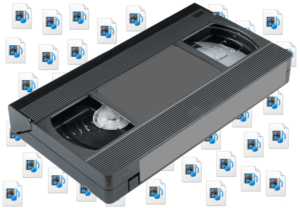When you’re digitizing a large number of videos, you’ll need to choose an appropriate format for the digital files.
Most video formats use compression, which reduces the data (and consumes less space on your storage media). Without compression, a single frame of typical video is around 5 megabytes (MB), which translates to around 150MB per second.
The exact size of the file varies depending on the resolution of the film. A 2-hour long, 8K resolution movie would take up about 14.5 terabytes (TB).
Uncompressed video takes up an enormous amount of storage space, which may be impractical for larger archives. Compression solves this issue, but with a few drawbacks.
Lossless vs. Lossy Video Compression
In most cases, compression is “lossy”: It reduces the quality of the video — but depending on the format, the reduction in quality may not be noticeable. Lossy compression is appropriate when preparing videos for streaming, or in other situations where the quality of the video isn’t especially important.
An alternative is lossless compression, which works by eliminating redundancy. The redundant data is simply stored more efficiently, reducing the storage requirements without impacting the quality of the video.
In summary:
- Lossy compression reduces the file size by removing some of the original data. That being said, it takes quite a bit of removed data for most people to notice a decrease in quality. It is more often noticed in a file that has experienced “data decay” due to repeated compressions and decompressions.
- Lossless compression restores and rebuilds the original video without losing any data or sacrificing quality in the process. However, lossless compression does not reduce the file size nearly as much as lossy compression, so the user is still stuck with a fairly large file.
Popular Lossless Video Codecs
You cannot determine whether a video is lossy or lossless by looking at the file extension — the file format is simply a container. You’ll need to look at the video’s codec, which compresses and decompresses the digital file.
The most popular lossless video codecs include:
- H.264 Lossless
- H.265 Lossless (HEVC)
- FFV1 / RFC 9043
- Apple Animation / QuickTime RLE
- Microsoft RLE
- MPEG-4 ALS
- VP9
- AV1
These codecs vary in the compression algorithms used, their support for different block sizes, and their licensing requirements.
What about “virtually lossless” compression codecs?
Some codec creators advertise their products as “virtually lossless.” While these compression codecs look indistinguishable from uncompressed video, they still lose some of the original signal — but the much lower file size may be worth the tradeoff.
Whatever codec you choose, avoid converting the file to another codec/format. Re-converting the compressed file leads to more significant and noticeable artifacts.
Related: Eliminate Combing In Digitized Betacam Video
Choosing a Format for Video Digitization
In most cases, you’re digitizing videos for preservation — and depending on the age of the tapes, you may have one opportunity to get the best possible reproduction of your sound and video.

Unfortunately, many video conversion services are geared towards home users, and lossy compression is fairly standard. When evaluating digitization services, determine whether they use lossy compression and ask whether they offer choices of different codecs.
Datarecovery.com specializes in at-scale video digitization. Prior to work, we discuss digitization formats with our clients to find an appropriate balance of video quality and storage feasibility — and with custom organization databases and flexible turnaround times, we provide an exceptional solution for larger digitization projects.
We provide solutions for the dozens of types of analog film, including:
- Betacam, Betacam SP, MPEG-IMX and Digital Betacam (DigiBeta)
- 3/4 U-Matic Cassettes
- Reel-to-Reel Systems Including 8mm, 16mm, and Super 8
- 8mm, Hi9, and Digital 8 Cassettes
- MiniDV
- MicroMini
- VHS, VHS-C and Betamax Tapes
- DVDs and MiniDVDs
Datarecovery.com laboratories are also equipped to repair damaged tapes. For a free estimate, submit a case online or call us at 1-800-237-4200.





